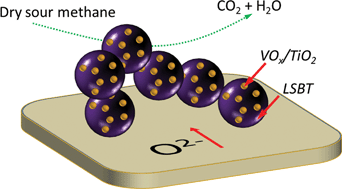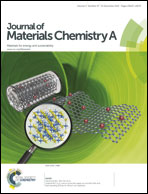Highly cost-effective and sulfur/coking resistant VOx-grafted TiO2 nanoparticles as an efficient anode catalyst for direct conversion of dry sour methane in solid oxide fuel cells†
Abstract
In this work, we show that grafted metal oxide can be a highly cost-effective and active anode for solid oxide fuel cells for sour methane conversion. The developed electro-catalyst was composed of vanadium oxide grafted TiO2 nanoparticles (VOx/TiO2) infiltrated into a porous La0.4Sr0.5Ba0.1TiO3+δ electron-conductive composite. A number of chemisorbed vanadia species on TiO2 have been identified by XRD, FTIR, XPS and ToF-SIMS analyses; the morphologies of grafted TiO2 nanoparticles were characterized using SEM and TEM. The thermal stability of vanadia was greatly enhanced due to strong binding interaction with the support. In the chemical activity investigation using a fixed bed catalytic reactor, VOx/TiO2 showed significantly improved activity towards sour methane gas (0.5% H2S + CH4) oxidation in a diluted stream of oxygen. The electrochemical activity was determined using a SOFC that employed the VOx/TiO2 infiltrated titanate anode. This cell had a maximum power density of ∼160 mW cm−2 and a non-ohmic polarization resistance of <1 Ω cm2 in 0.5% H2S + CH4. Additionally, the performance of the novel anode material did not degrade during the 24 h test at 0.7 V with VOx/TiO2 suppressing coke formation on the anode.


 Please wait while we load your content...
Please wait while we load your content...